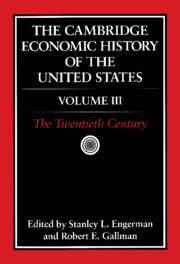Book contents
- Frontmatter
- 1 American Macroeconomic Growth in the Era of Knowledge-Based Progress: The Long-Run Perspective
- 2 Structural Changes: Regional and Urban
- 3 Twentieth-Century Canadian Economic History
- 4 The Twentieth-Century Record of Inequality and Poverty in the United States
- 5 The Great Depression
- 6 War and the American Economy in the Twentieth Century
- 7 U.S. Foreign Trade and Trade Policy in the Twentieth Century
- 8 U.S. Foreign Financial Relations in the Twentieth Century
- 9 Twentieth-Century American Population Growth
- 10 Labor Markets in the Twentieth Century
- 11 Labor Law
- 12 The Transformation of Northern Agriculture, 1910–1990
- 13 Banking and Finance in the Twentieth Century
- 14 Twentieth-Century Technological Change
- 15 The U.S. Corporate Economy in the Twentieth Century
- 16 Government Regulation of Business
- 17 The Public Sector
- Bibliographic Essays
- Index
- References
2 - Structural Changes: Regional and Urban
Published online by Cambridge University Press: 28 March 2008
- Frontmatter
- 1 American Macroeconomic Growth in the Era of Knowledge-Based Progress: The Long-Run Perspective
- 2 Structural Changes: Regional and Urban
- 3 Twentieth-Century Canadian Economic History
- 4 The Twentieth-Century Record of Inequality and Poverty in the United States
- 5 The Great Depression
- 6 War and the American Economy in the Twentieth Century
- 7 U.S. Foreign Trade and Trade Policy in the Twentieth Century
- 8 U.S. Foreign Financial Relations in the Twentieth Century
- 9 Twentieth-Century American Population Growth
- 10 Labor Markets in the Twentieth Century
- 11 Labor Law
- 12 The Transformation of Northern Agriculture, 1910–1990
- 13 Banking and Finance in the Twentieth Century
- 14 Twentieth-Century Technological Change
- 15 The U.S. Corporate Economy in the Twentieth Century
- 16 Government Regulation of Business
- 17 The Public Sector
- Bibliographic Essays
- Index
- References
Summary
INTRODUCTION
In 1990, for the first time, a majority of the U.S. population lived in metropolitan areas with more than one million people. More than half of these thirty-nine areas were in the South and West (see Figure 2.1). Only five such areas (New York, Chicago, Philadelphia, Boston, and Pittsburgh) had existed in 1900. Then they held 15.5 percent of the U.S. population, and all were in the Northeast and Midwest. During the intervening decades the boundaries, internal structure, and economic roles of U.S. regions and urban areas altered dramatically.
A national economy can be thought of spatially in at least two ways: as a set of regions or as a system of cities. These are not mutually exclusive. Although often defined by industrial specialization (agricultural, extractive, or manufacturing), a region also can be defined as a nodal metropolis structuring a surrounding area. Historically, regions and cities have influenced each other in numerous ways. But in the United States and else-where their relative importance for economic growth has changed over time. The system of cities has assumed the dominant role in the twentieth century.
Growth in capitalist economies depends upon continually shifting boundaries or frontiers: spatial, technological, and social. The expectation of high financial returns on each of these frontiers, although not always realized, drives the investment that sustains aggregate growth. New territories are developed and new cities constructed. Technological innovations are conceived and embodied in equipment and organizations. Firms do not simply reallocate resources already employed, but expand and contract the social boundaries of the system of firms.
- Type
- Chapter
- Information
- The Cambridge Economic History of the United States , pp. 93 - 190Publisher: Cambridge University PressPrint publication year: 2000
References
- 6
- Cited by



